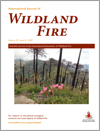International Journal of Wildland Fire
Volume 29
Number 8 2020
Fire is a major disturbance process influencing the Andean Araucaria forest landscape of north-west Patagonia. Reconstructed fire history shows the striking influence of Native American and European-Chilean settlement land-use practices on the fire regime. Widespread fires are favoured by regional interannual climate variability related to large-scale climate forcings (SAM, ENSO).
We estimated carbon (C) emission and uptake in three severely burned Andean cypress stands of Patagonia, Argentina, that had similar pre-fire biomass but grew under different environments. Carbon emissions were similar in the three sites, but differences in environmental site conditions caused significant variation in their C recovery rates.
The thermo- and physicochemical properties of exotic and native species foliage were used to identify which species favour wildfires and their propagation in the Valparaíso region, Chile.
Re-introducing fire in mountain big sagebrush communities dramatically increased herbaceous biomass and subdominant shrubs, creating spatial and temporal heterogeneity. Exotic annual grasses increased in the short term, but over time decreased to ~1% cover. This study suggests that management may need to include infrequent fire to maintain a diversity of plant communities.
Dormant season grassland fuel loads can be laborious to estimate using traditional clip, dry and weight methods. A simple method of using small unmanned aircraft systems, in conjunction with analysis software, can provide useful estimates of grass biomass immediately before a prescribed burn.
We describe the wildfire regime of the north-eastern Simpson Desert and the relationship between wildfire extent and rainfall. Extreme rainfall can predict large wildfires that occur 2 years later. Extreme rainfall is predicted to increase in the future, which could alter current fire regimes and threaten natural processes and ecosystems.
We modelled fire occurrence in four regions across the Alps and the Mediterranean Basin and developed a cross-regional model. We assessed the effect of spatial resolution on model performance and tested the spatial transferability of the models. Results showed that (1) increasing spatial resolution increased model performance and (2) spatial transferability was generally best with the cross-regional model.
This work presents a new version of the ‘Balbi model’, which currently takes into account radiation and convection as heat transfer modes and more importantly, has no variable model parameters. The model is applied to a huge set of laboratory experiments resulting in only a small error.
This research summarises current applications and improvements to methods used to characterise wildfire suppression difficulty in forested landscapes. We demonstrate application of a suppression difficulty index variant developed for real-time decision support on fires in the USA and a series of recent improvements applied to a wildfire in Spain.





